Clancy Tucker's Blog, page 54
April 1, 2021
6 May 2021 - INTERESTING FACTS ABOUT THE TITANIC
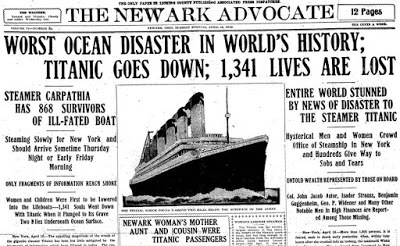
INTERESTING FACTS
ABOUT THE TITANIC
G'day folks,
We've all heard about it, but here are some interesting facts.
April 15, 1912 — On her maiden voyage from Southampton to New York, the passenger liner Titanic hit an iceberg and sank on this day in history, resulting in the world’s worst peacetime shipping disaster.
Five days earlier the toweringly impressive ship — eleven storeys high, a sixth of a mile long and weighing 46,328 gross tons — slipped her moorings at Southampton to the cheers of awestruck crowds. She was the pride of the White Star Line, the biggest ship the world had seen, and certainly the best.
For a single crossing the “millionaire suites” cost up to £870 ($1,200) — equivalent to about £44,000 ($62,000) today — and were designed, as one newspaper reported, “for the financial giants of our time: men who could lightly pay for this single voyage the year’s keep of ten British families.”
There was no shortage of takers for the ship's wondrous facilities. Leaders of industry, finance and commerce and figures from British and European aristocracy were joined by members of some of the wealthiest families in the United States.
They included Benjamin Guggenheim, whose fortune lay in mining, smelting and banking; Isidor Straus, whose money came from commerce and banking and his partnership in the famous Macy's department store; George Widener, son of tramway magnate P A B Widener, said to be the wealthiest man in Philadelphia; Charles Melville Hays, president of the Canadian Grand Truck Railroad; and John Jacob Astor, perhaps unkindly described by one journalist as “the world's greatest monument to unearned income.”
Astor had divorced in 1909 and two years later, at the age of 45, married 18-year-old Madeleine Force, a girl younger than his son, Vincent. Society was outraged and Astor went abroad with his young bride to escape criticism. They were now returning, Madeleine five months’ pregnant and Astor anxiously wondering if he would be able to regain his old position in New York society.
They and some 2,200 other souls were enjoying their sumptuous surroundings when, at 11.40pm on the fifth night out, lookout Fred Fleet, peering from the crow’s nest into a calm, clear night bursting with stars, spotted something directly ahead.
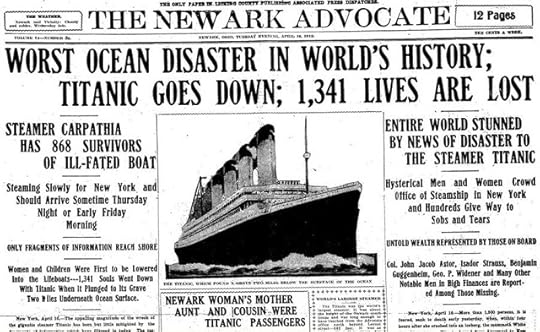
Walter Lord, in his book A Night to Remember, tells dramatically what happened next: “At first it was small, but every second it grew larger and closer. Quickly, Fleet banged the crow’s nest bell three times — the warning of danger ahead. At the same time he phoned the bridge. ‘What did you see?’ asked a calm voice at the other end. ‘Iceberg right ahead,’ replied Fleet.
“For the next 37 seconds Fleet watched the ice draw nearer. Now they were almost on top of it and still the ship didn’t turn. The ‘berg towered wet and glistening far above the forecastle deck and Fleet braced himself for a crash. Then, miraculously, the bow began to swing to port. At the last second the stern shot into the clear and the ice scraped swiftly by along the starboard side. It looked to Fleet like a close shave.”
He was mistaken. The jarring of a collision brought Captain Edward J Smith rushing from his cabin to the bridge, resulting in an exchange recounted at the subsequent inquiry in New York: “Mr Murdoch, what was that?”
“An iceberg, sir. I hard-a-starboarded and reversed the engines and I was going to hard-a-port around it, but she was too close.”
“Close the emergency doors,” Smith snapped. But First Officer William Murdoch had already thrown the switch that sent the massive doors crashing into place. The ship was divided into 16 watertight compartments which could be sealed by these doors in the event of an accident. This feature, in addition to the Titanic’s double bottom, prompted the Shipbuilder magazine to describe the great vessel, in what turned out to be a haunting epitaph, as “practically unsinkable.”
More colourfully, passenger Mrs Albert Caldwell, who boarded at Southampton, remembered asking a crewman if the ship really was safe. “Lady,” he replied, “God himself could not sink this ship.”
Thomas Andrews, managing director of Harland & Wolff, builders of the ship, made a tour of inspection and found that the first five compartments were flooding, suggesting a 300ft gash.
Andrews, wrote Walter Lord, explained to the captain what this meant: “The Titanic can float with any two of her 16 compartments flooded. She can even float with her first four compartments gone, but she cannot float with her first five compartments full.
"The bow will sink so low that water in the fifth compartment must overflow into the sixth. When this is full, it will overflow into the seventh, and so on. It is a mathematical certainty — the ship is doomed.”
As the crew began loading passengers into the pitifully few lifeboats, Second Officer Charles Lightoller was supervising the loading on a strict “women and children only” basis. He was at the centre of a much reported incident when John Jacob Astorhelped his wife into boat No 4 then asked if he could join her. “She is,” he said, “in a delicate position.”
“No, sir,” Lightoller told him. “No men are allowed in these boats until the women are loaded first.” Astor had a fortune of $4,250 cash in his pocket at this time. “It was about as much use to him,” wrote Geoffrey Marcus in The Maiden Voyage, “as the $150 million he possessed ashore.”
There were 16 lifeboats, plus four “collapsibles”. Altogether, they could carry 1,178 people. But there were more than 2,200 aboard the Titanic.
One man who did step into a boat — he insisted at the subsequent British and American inquiries that it was being lowered, there was room in it and there was no one else around — was the White Star Line chairman J Bruce Ismay.
He later came under fierce criticism, summed up by Rear Admiral A T Mahan, speaking to reporters: “So long as there was a soul that could be saved, the obligation lay upon Mr Ismay that that one person — and not he — should have been in the boat.”
While the drama was unfolding, members of the ship’s orchestra helped to keep up morale by playing ragtime tunes. One of the myths that grew was that as the ship went down the musicians played the hymn Nearer My God to Thee.

Clancy's comment: Interesting accounts at the time. Bigger ain't always better, eh?
I'm ...


March 30, 2021
4 May 2021 - THE HOT SPRINGS OF PAMUKKALE, TURKEY

THE HOT SPRINGS OF
PAMUKKALE, TURKEY
G'day folks,
The end of January and all of February is always the most challenging part of winter when the weather has been cold for quite some time and we all start passionately missing the warmth of the sun. At times like these, hot springs and thermal baths come to the rescue, as they combine the two things we all can appreciate: a relaxing warm soak and a picturesque view.
The terraced hot springs of Pamukkale formed naturally, although they do look quite unbelievable, much like an alien landscape described in a science fiction novel. The springs consist of 17 azure-blue tiered pools made of travertine, a type of white limestone deposited from the minerals present in the water.

The water in Pamukkale is a pleasant 94°F (34°C) all year. The hot springs have been in use as a thermal spa for centuries. In the 2nd century BC, the Romans built a spa city and a healing center called Hierapolis nearby. Today, both the Roman city and the hot springs of Pamukkale are a UNESCO World Heritage Site.

Clancy's comment: Ahhh ... delightful place to relax.
I'm ...


3 May 2021 - AMAZING FLOWER PARADES - ZUNDERT, NETHERLANDS

AMAZING FLOWER PARADES
- ZUNDERT, NETHERLANDS -
G'day folks,
Flower parades are held all over the world, but the one that takes place in Zundert, the Netherlands, is extraordinarily artistic. It’s also the largest parade in the world. Huge floats are made of wire, cardboard and Papier-mâché', and entirely covered in dahlias in intricate designs. The dahlias for grown specifically for the parade, and thousands of them are required just to cover one float.


The huge floats are made by twenty different hamlets and each of them consists of hundreds of builders, aged 1 to 100, who are all equally crazy about the Bloemencorso. The older members of the hamlet are often responsible for planting and growing the dahlias, while the younger ones build the float in large temporary tents that are built exclusively for the event.
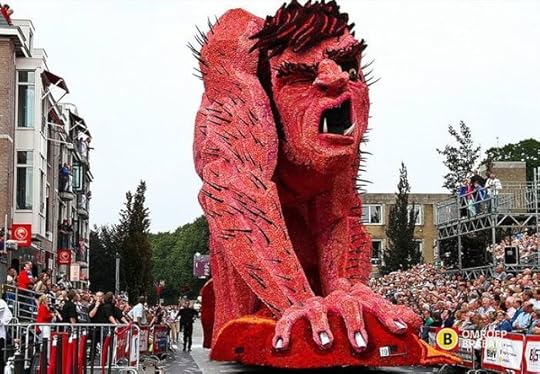


Building a float for the Bloemencorso is mainly a social event. Builders of all ages work side by side for over three months to get the float of their hamlet ready on time. It has to be as perfect as possible in order to win the competition. The parade itself takes place on the first Sunday of September, but the members of the hamlets work on their floats all summer. The tents are put up in May or June and from then on the volunteers put all their effort in creating the giant artworks. The last three days before the actual parade are the most stressful.



Because the flowers have to be fresh, the hamlets can only start applying the dahlias on the floats on the Thursday before the parade. If necessary, the builders will work day and night to have their float ready on Sunday.
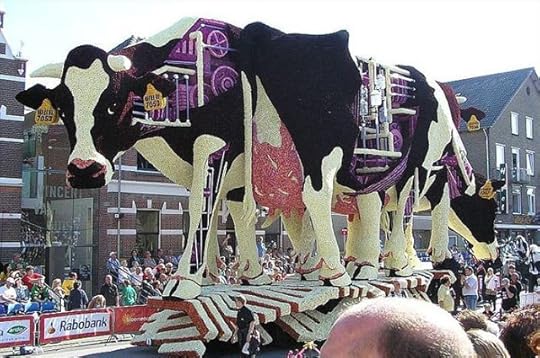



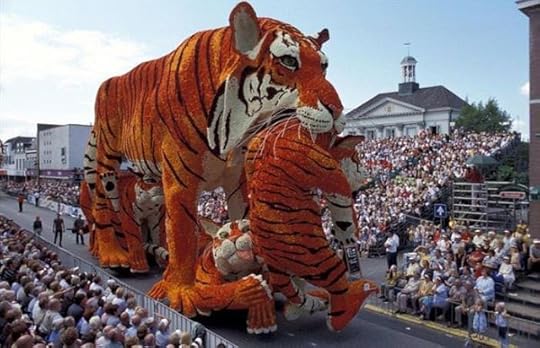
Most people in Zundert will happily give up their days off to work on the float. The social cohesion that comes from building it is very important. A hamlet is like a family where everyone knows each other and everyone is welcome. After a long evening working on the float people drink a beer together and most hamlets organize all kinds of other activities like song contests and barbecues.

Clancy's comment: Beautiful. What an extraordinary amount of work involved.
I'm ...


March 29, 2021
2 May 2021 - THE FIRST TERRIFYING TOP HAT

THE FIRST TERRIFYING
TOP HAT
G'day folks,
January 15, 1797 — Fred Astaire hardly ever seemed to be without one and for men it seems to be the essential item of apparel at every formal occasion – from weddings to presidential inaugurations: the top hat.
And the man who gave it a head start into fame and fashion was haberdasher John Hetherington who, on this day, appeared in court after he had stepped out onto the streets of London wearing the distinctive headgear. It caused a sensation.

So much so that a crowd formed and Hetherington was eventually arrested and given a summons for disturbing the public peace. In court, found guilty of wearing a hat “calculated to frighten timid people”, he was bound over to keep the peace in consideration of a sum of 50 pounds.
The arresting officer told the court that nobody had seen anything like it before: “He had such a tall and shiny construction on his head that it must have terrified nervous people. The sight of this construction was so overstated that various women fainted, children began to cry and dogs started to bark. One child broke his arm among all the jostling.”

The next day, The Times newspaper reported: “Hetherington’s hat points to a significant advance in the transformation of dress. Sooner or later, everyone will accept this headwear. We believe that both the court and the police made a mistake here.”
The newspaper was right. The top hat, which went by several names including Toppers, Chimney Pots, and Stove Pipes, grew in popularity, finally achieving the ultimate stamp of respectability in 1850 when Prince Albert, no less, began to wear one, giving the headgear the royal seal of approval. There was no going back after that . . .

Clancy's comment: Wow. I wonder if the same happened when the mini skirt was introduced? I doubt it.
I'm ...


30 March 2021 - INSPIRATIONAL QUOTES WORTH READING

INSPIRATIONAL QUOTES
WORTH READING
G'day folks,
Feeling down? Well, check these wise words.











Clancy's comment: I hope they fired you up. Now, pass them onto others.
I'm ...


March 27, 2021
10 May 2021 - LUXOR TEMPLE, EGYPT
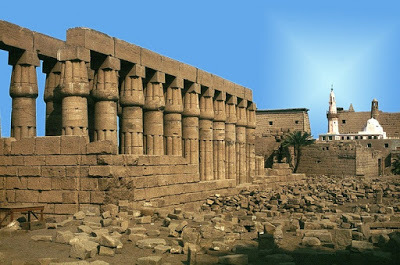
LUXOR TEMPLE, EGYPT
G'day folks,
This temple is Located on the east bank of the Nile River in Luxor, in the ancient city of Thebes. The Luxor Temple was built in 1,100 and 1,600 BC during the reigns of several pharaohs - Amenhotep III (1390-52 BC), Tutankhamun (1336-27 BC), and Horemheb (1323-1295 BC), and then added to by Rameses II (1279-13 BC). The temple was dedicated to the three Egyptian gods Amun, Mut, and Chons, and is considered the largest and most important site in ancient Egypt. The Luxor temple served as a place of worship for nearly 3,500 years and was also the center of the festival of Opet (ancient Egyptian festival of the second month of the lunar calendar).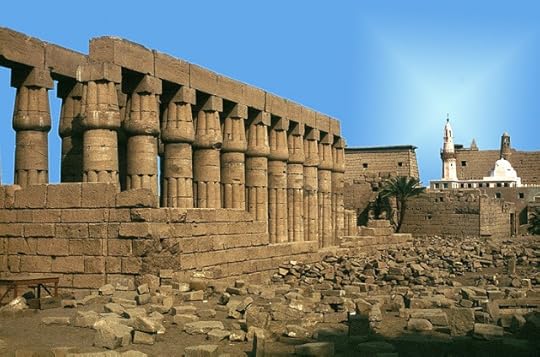
According to Egyptian legends, the Luxor Temple was “the place of the First Occasion,” where the god Amun experienced a rebirth. Today, the massive Great Colonnade Hall is one of the most vital remains of this vast temple complex.
 Clancy's comment: The age of these temples is gob smacking.
Clancy's comment: The age of these temples is gob smacking. I'm ...


5 May 2021 - TEMPLE OF AMADA, EGYPT
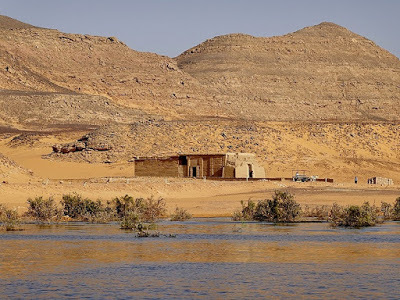
TEMPLE OF AMADA, EGYPT
G'day folks,
The Temple of Amada is one of the oldest temples in Egypt and was first constructed by Egyptian pharaoh Thutmose III of the 18th dynasty, sometime around the 15th century BC.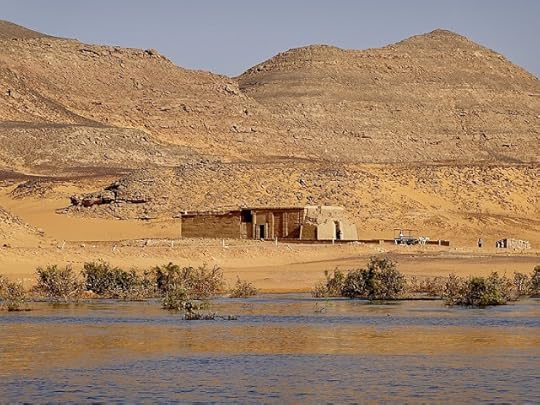
Dedicated to the gods Amun and Ra-Horakhty, the temple is considered to be one of the earliest examples of Egyptian temple architecture in the area of the Middle Nile. While it was originally constructed on the east bank of the Nile, the Temple of Amada was moved in the 1960s and '70s to a higher site on Lake Nasser to protect it from flooding. One of the most significant features of the temple is a relief along with two important inscriptions describing the military feats of the pharaohs who built it - Tuthmosis III and his son Amenhotep II. While the temple is quite small and dilapidated, it is still quite fascinating and vibrant from inside.

Clancy's comment: Imagine moving a temple this old?
I'm ...


March 26, 2021
1 May 2021 - ARTISTIC WATERMELON CARVINGS

ARTISTIC WATERMELON
CARVINGS
G'day folks,
We've seen food carvings before, but the competitors in this watermelon carving competition have undeniably elevated the genre to a higher art form! And if you think it looks easy, just remember that any tiny mistake requires you to start all over again with a new watermelon.











Clancy's comment: Amazing skills, eh?
I'm ...


27 March 2021 - WHO INITIATED THE FIRST SUSPENSION BRIDGE?

WHO INITIATED THE
FIRST SUSPENSION BRIDGE?
G'day folks,
The Inca people of South America were noted for making durable suspension bridges by weaving mountain grasses and other vegetation into thick cables. These sturdy ropes were ideal for crossing long gorges and were called simp’achaka, which means “braided bridges.” Workers would create the cables at the site where the bridge was to be erected and it was a technique that was used centuries later for the construction of the Brooklyn Bridge in New York City in 1864.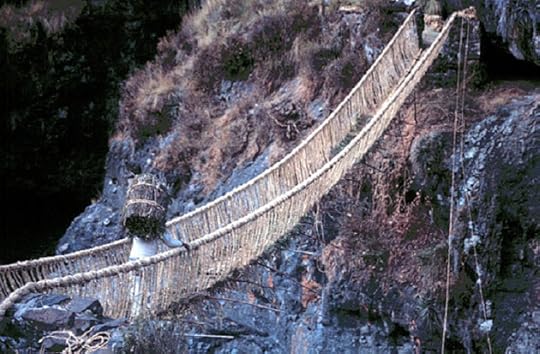
Many of these suspension bridges stretched longer than what even European engineers of the time had made with stone. Today, the last remaining Incan-style grass cable suspension bridge, the Queshuachaca, can be found over a gorge in Peru’s Canas Province.

Clancy's comment: I've walked on some of these bridges and did so with great fear.
I'm ...


March 25, 2021
29 April 2021 - FACTS ABOUT WOODROW WILSON - 28th US PRESIDENT
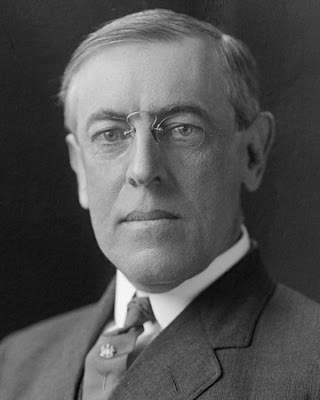
FACTS ABOUT WOODROW WILSON - 28th US PRESIDENT -
G'day folks,
A progressive politician, Woodrow Wilson became President of Princeton University in 1902, Governor of New Jersey in 1910 and was nominated for President by the Democratic Party in 1912.
Wilson served two terms. His first saw the introduction of progressive legislation that would be unseen in scale until Franklin D. Roosevelt's New Deal in the 1930s. This legislation included the Federal Reserve Act, the Underwood Revenue Act, the Clayton Antitrust Act, the Federal Farm Loan Act and child labor laws.
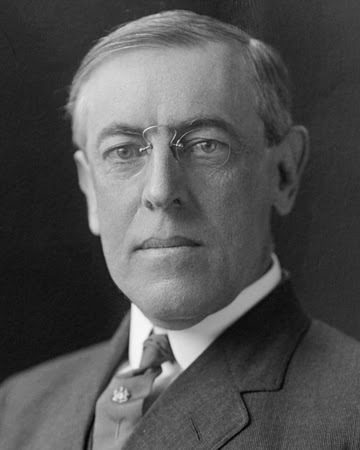
In 1914, World War I broke out and Wilson maintained neutrality, while pursuing a more aggressive course in Mexico's civil war. Wilson became the first Democrat since Andrew Jackson to be re-elected to consecutive terms in 1916. The following year, when Germany resumed unrestricted submarine warfare and the existence of the Zimmerman Telegram was disclosed, he changed his earlier stance on entering the war and asked the Senate to declare war on Germany, taking the country into the final stages of World War I.
After the Allied victory he was instrumental in negotiating the Treaty of Versailles and establishing the League of Nations. Wilson had first put forward the idea of a League as part of his 'Fourteen Points' speech in a Senate address.
In 1919 he won the Nobel Peace Prize. The same year he suffered a severe stroke which left his power and influence diminished, and the Treaty of Versailles was eventually rejected by the Senate. He lost a bid to be re-nominated at the Democratic National Convention and left office in 1921, before dying in 1924.

Clancy's comment: He led a full life, and certainly had some challenging moments.
I'm ...





